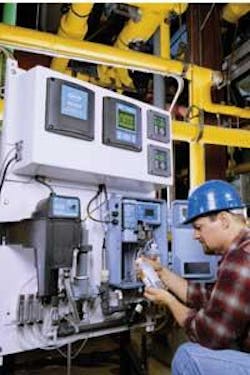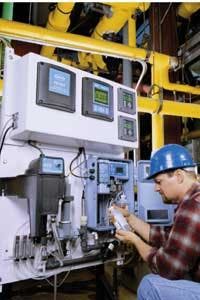Distribution Network Monitoring Detects Contaminants
Industry leaders increasingly are questioning the health of the country's water distribution systems that include thousands of miles of aging pipeline. Utilities are looking to improve operations and maintenance (O&M) on trimmed-down budgets. And, facilities large and small are scrutinizing their systems, including all distribution network components, for security evaluation.
Hach's Water Distribution Monitoring Panel offers a solution to each of these significant issues. It packages on-line analysis of chlorine residual, pH or ORP, conductivity, turbidity, pressure, and temperature, so utilities can track distribution system performance, detect accidental or intentional contaminants as they occur, and identify time-related decay of water quality during transport through the network.
The panel is one of the least expensive means available to assess distribution system health, identify opportunities for O&M improvement, and detect system abnormalities warranting operator attention.
System monitoring
Effective distribution system monitoring requires more than snapshot, grab-sample testing; even a healthy distribution network is a dynamic system that varies daily with operations and demand changes. Continuous monitoring is a practical way to profile the system, assess infrastructure, and quantify the normal variation in water quality parameters due to daily and seasonal changes in flow, flow direction, and temperature.
After a period of surveillance to establish a distribution system baseline, operators will have a very good characterization of the system's normal dynamics. Armed with this information, they can recognize significant variations, for example, the pH or alkalinity change that predicts the onset of a nitrification event, infrastructure leaching, or corrosion and potential non-compliance with the Lead and Copper Rule.
Real-Time Response
Continuous water quality surveillance with the Hach Distribution Monitoring Panel detects the basic chemical and physical changes in treated water that are likely when contaminants enter the system. Such contamination may be due to intrusion of non-potable water from leakage points, faulty joint seals, or submerged air valves. It may be the result of pressure transients caused by main breaks, power failure, pump drawdown, flushing operation, or a sudden change in demand. Contamination often occurs with cross-connection and backflow associated with main construction or repair, from sources such as an industrial plant, sprinkler system, cooling tower, or pesticide applicator.
Nearly all utilities temporarily experience these conditions. Further, industry leaders and homeland security officials claim the potential for intentional contamination of a water distribution system through purposeful cross-connection and backflow.
Because of the transient nature of such contamination events, continuous monitoring with real-time notification provides operators more chance to detect potential problems and improve reaction time than a grab sampling strategy. The panel provides analog (4-20 mA) output for PLC, RTU, and chart recording or optional digital (ModBus®) communication to PLC and SCADA. An optional American Sigma 900 MAX Auto Sampler immediately captures a discrete sample for further analysis when an out-of-limit condition occurs.
O&M, Compliance
On-line monitoring, data management, and automatic sampling yield the benefits of a cadre of operators attending to points throughout the distribution network – without the labor and time costs. Instead, with automated panel monitoring, utility personnel have both timely information to improve O&M and the time to do it.
On-line turbidity measurement tracks the accumulation of sediments during construction, rehabilitation, and repair of water mains performed on a regular basis. Continuous turbidity measurement also can alert operators to sloughing of biofilms and the presence of post-precipitation of iron or aluminum flocs.
Continuous chlorine measurement helps optimize disinfectant application and booster station operation, particularly important for combined and consecutive systems where distribution from producer to end-user becomes longer. Reliable residual quantification helps meet SWTR compliance, identifies critical sampling locations and worst sites for D/DBPR compliance and DBP management.
An optional Hach TOC Analyzer detects the natural organic matter that can enhance chloramine decay and contribute ammonia. Some utilities may find an additional monitoring parameter such as fluoride or alkalinity is appropriate.
The Water Distribution Monitoring Panel offers design, construction, and methodology that makes it a practical tool for utilities large and small. All instruments are fully integrated with a single sample port and drain and are pre-wired and mounted on an ABS plastic panel with stainless steel supports.

